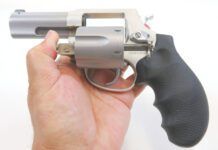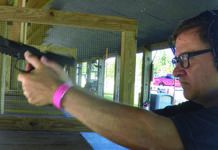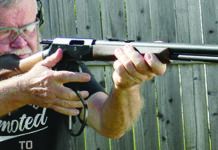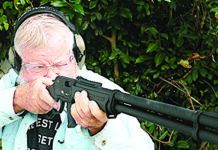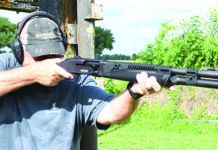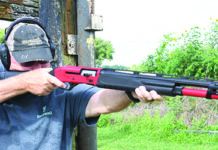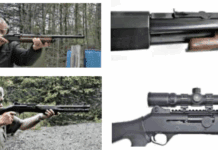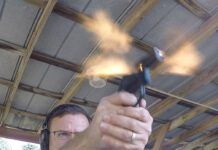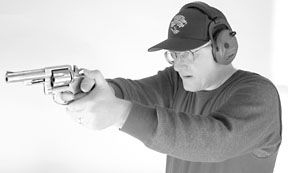
Service weapons have never been the fanciest, most expensive sidearms available. But they have always been required to offer power, reliability, and long service life. It wasn’t long ago that the .357 Magnum revolver was the standard sidearm for police, and for that matter, the choice of those on the other side of the law as well. Today, the semi-auto is the more popular handgun for police work by far. While there are still many revolvers on the job, one might ask what happened to all those wheelguns of yesteryear? After the wave of semi-auto mania swept through the ranks of law enforcement, advertisements in publications such as Gun List and Shotgun News still offer used police-type revolvers at bargain prices. Calling up your buddy who just happens to have an FFL, or asking your local gun shop to transfer one of these guns for a nominal fee (usually $25) is no big deal. And a recent test of three proven wheelguns showed us there can be incredible bargains out there for the asking.
Gun Tests readers already know we have gone looking for cheap semi-autos this year and come up lacking, so we decided to see if the simple steel revolver was a better choice. We didn’t have to go through a long process of selection. We merely bought copies of Gun List and Shotgun News and purchased whatever magnums were available that week. Thus, creating a matchup of steel, six-shot, .357 magnums with four-inch barrels was easy. We paid $190 for a Ruger Police Service Six and $219 for a Smith & Wesson model 66-2. We did not pay the extra $10 for a “hand picked” model in either case as advertised. Colt revolvers have always been coveted due to lower production numbers and famed “hand tuning,” so we paid more, $350, for a Colt Trooper Mark III.
Warranty when buying a gun under these conditions is generally limited to a short inspection period of less than one calendar week. Thus, knowing what to look for is the key, and we hope the following information will help. We couldn’t wait to find out what condition our guns would arrive in and how they compared in performance to the latest models from their respective manufacturers.
Range Session
Each gun arrived clean but showed varied degrees of wear. Our first step was to remove the grips and immerse each one in a bucket of Dunk-It. This is a cleaner/lubricant made by Cylinder and Slide, (800) 448-1713, that removes deposits by getting underneath lead and other debris. This step alone reduced the weight of the double-action trigger pull of each revolver (as much as one pound in the case of the Smith & Wesson). We made a thorough inspection of timing, cylinder gap, headspace, lockup and frame. We inserted a plastic rod into the barrel at point of lockup in both single and double action so that it contacted the breechface. Dropping the hammer of each gun produced enough force at the firing pin to send the rod flying. So we knew right away that misfires at the range would be unlikely.
[PDFCAP(1)]
Our next obstacle was familiarization. Even though each test gun is a six shot revolver of very nearly the same weight, the mechanism by which Colt, Smith & Wesson and Ruger go about making them fire gives each one a distinct personality. For this reason we spent an entire day checking the sights and shooting steel plate racks with the guns. A light handload of Hodgdon’s Universal Clays in a magnum case under a 125-grain bullet served as our practice round. Each revolver was fired a minimum of 150 rounds in this session. Accuracy results were conducted the following day after a re-inspection of the guns.
We found the double action of the Colt to be inordinately heavy for repeated slow fire from our sandbag rest, so we decided to test all three guns for accuracy in single-action only. Test distance was 25 yards. We used an Oehler 35P chronograph to measure velocity and compute standard deviation. We ignored the fact that each gun is capable of firing .38 Special ammunition and concentrated on three jacketed hollow-point cartridges typical of .357 Magnum ammunition. This included Winchester’s 110-grain JHP, and from Black Hills Ammunition, 125- and 158-grain JHP rounds. Here’s what we found.
Colt Trooper Mark III, $350
The Colt Trooper was made from 1953 to 1969. The Trooper Mark III superceded the Trooper and had a redesigned lock mechanism. It was manufactured from 1969 to 1983 in blue and nickel finish with 4-, 6-, and 8-inch barrel lengths. An owner’s manual can be obtained by calling Colt at (800) 962-2658. The Trooper III in our test was made in 1974.
[PDFCAP(2)]We bought the Colt Trooper MK III from R.V. (Dick) McGaughy F.F.L., (713) 270-4238. He offered a three-day inspection. We paid a published dealer price of $350; retail price is $400. Blue Book lists the gun’s value as between $225 (95 percent), $325 (98 percent), and $395 (100 percent).
The Colt Trooper Mark III is for all practical purposes the working man’s Python. Sound good? It features a serrated front sight pinned in place. The rear sight is fully adjustable, and it should be more durable than similar designs since the rear notch moves back and forth inside a protective frame. While adjustment for elevation is clockwise for down and counter-clockwise for up, the windage adjustment is reversed. Turn it to the right if you want the point of impact to move left, and turn left to bring the POI to the right.
Another feature is the direction in which the cylinder rotates. While other revolvers move counterclockwise, expecting a Colt to go bang requires the first round to be in the 11 o’clock position prior to cycling. Also, to release the cylinder one pulls rather than pushes on the latch.
The Colt Trooper weighed the most, and as expected, produced the least felt recoil. While the 110-grain Winchester JHP was flashy and produced the lightest recoil all around, the Trooper tended to smother muzzle flip from each round across the board. Double-action trigger pull was very heavy (15.5 pounds), but this was not as noticeable when fired unsupported as from a rest. The resistance of initial take up is multiplied as the shooter reaches the end of the stroke. This has been commonly referred to as “stacking,” which is commonly associated with a coiled mainspring design. The single-action proved nearly as heavy as the double-action, which is unique in our test experience (12.5 pounds). But, the weight of the SA press, which was also desirably solid in feel, did not detract from our accuracy. The face of the trigger was wide, without serration and properly radiused. This last detail is not to be taken for granted, and it’s indicative of the extra time put into the construction of this revolver.
We are sure each of these actions could be lightened considerably, but bear in mind that while heavy, the action was very smooth without even a hint of grit, delay, or stumble. In fact the general condition of this weapon was quite good. We doubt this gun was likely fired only a couple of times and then put away. Wear on its blued finish was primarily at the muzzle—a classic sign of holster wear.
Each of our test revolvers featured a wood grip (walnut), but only the Colt and Smith &Wesson models offer the older design wherein the grip is wider at the bottom. The Colt grip was cut with a diamond pattern and the backstrap was exposed. The ejector rod was fully shrouded with an extra contour for the tip.
Our only mechanical irregularity throughout the test involved the Colt’s ejector rod backing out. This could be fixed with a carefully applied drop of Loctite.
In terms of accuracy, the Colt Trooper, like the other two guns, averaged five-shot groups approximately 2.5 inches in diameter with the 110-grain Winchester cartridge. Variation in group size was actually rather small. Likewise, all three guns shot the Black Hills 125- and 158-grain JHP rounds even better. Our Trooper preferred the 125-grain round, with a best single group measuring 1.4 inches for an average of 1.7 inches. Overall, our old Trooper Mark III averaged 2.1-inch groups for all shots fired regardless of cartridge. Muzzle energy from our Trooper Mark III ranged from 419 to 519 foot-pounds. Checking our data from a recent test of sub-compact .45 ACP pistols (November 2001), the Trooper offers more muzzle energy with comparable capacity at one half to one quarter the price.
Ruger Police Service Six, $190
The Ruger Police Service Six Model 707 was discontinued in 1988. It was superceded by the model GP-100, which is still in production. The stainless-steel version, which we tested, was only made with a 4-inch barrel. Our Service Six was produced in 1984. Our test Ruger Police Service Six came from KY Imports Inc., (800) 718-3643. KY offered a three-day inspection, and a published dealer price of $190 for a gun in very good condition, like our test sample. If you were to buy this gun, retail price would probably be around $225. Blue Book’s retail cost range was from $200 (95 percent) to $220 (98 percent) to $250 (100 percent). After we acquired our test sample, we learned KY Imports is currently out of stock on the Service Six. However, we believe the general availability of these guns is good at gun shows.
[PDFCAP(3)]The Security Six, Service Six, and Speed Six all used the same frame and only had slight differences elsewhere. The Service Six and Speed-Six were only made with fixed sights, the Security Six had adjustable sights. There were in excess of 1,210,000 guns of all three names produced. These guns were not only used by police in the United States, but several South American countries and Great Britain also purchased them.
The Security Six, at the time of its introduction in 1971, was hailed as an advanced double-action design. Most of the working parts can be removed as a single unit out of the bottom of the revolver. An owner’s manual can be obtained from Ruger by calling (603) 865-2442.
Frankly, we expected the Colt Trooper Mark III to be very good. We also expected the Smith & Wesson model 66-2 to be a good buy as well because we’ve had so much experience with these guns in competition. But the Ruger Police Service Six surprised us all with its overall best accuracy and power. In our view, this revolver is a Best Buy. Here’s why.
The Police Service Six utilizes an in-frame sight notch that is impervious to damage by abrasion. If you are used to seeing a big black rear blade you will be slower on sight with this arrangement until you learn what to look for. But the relation to the front sight is clear and definitive, helped by a blackened and serrated ramp-style blade up front.
Although the Ruger did not have the lightest action, its ergonomics were very good. The trigger seemed the most eager of the three revolvers. Also, even at 38 ounces of heft, the gun is surprisingly comfortable to carry.
While the walnut grip is only a brief set of “old-school” panels with the frame exposed all around, this gun fit the most hands and afforded the highest grip, essential to controlling recoil. But since there are now so many variations on the market, we suspect most shooters will choose to replace these simple grips (which are reminiscent of Western gear) with one of the today’s modern designs. We think the same could probably be said for each of our test guns.
Releasing the cylinder is as close to a push button operation as you can get, and no special dexterity is needed. We think this is the fastest mechanism of all, yet lockup on the Ruger was the strongest, in our opinion. Lockup is at the tip of the ejector rod (fully shrouded), and we couldn’t help but notice that the cylinder stop is tall and stout.
Obviously, our Police Service Six had not spent its life sitting in a drawer, since signs of wear were evident. Still, the stainless steel finish was handsome enough.
Overall accuracy for all shots fired averaged only 1.8 inches. These are slightly better results than we were able to record with Ruger’s GP100, a similar model in our April 2000 issue, which included .38 Special ammunition as well as .357 Magnum fodder. Our Police Ruger’s most accurate choice of ammunition also produced the most power. The Police Service Six combined with Black Hill’s 125-grain JHP to produce 532 foot-pounds of muzzle energy with a best group of 1.1 inches (1.4 inches on average). However, without the luxury of adjustable sights, the shooter has to rely on choosing the correct bullet weight to produce the intended point of impact. Our hits at 25 yards with the 125-grain round actually printed a couple of inches low. The heavier 158-grain rounds printed dead on. A slight adjustment of the height of the front blade would adapt the Ruger to the lighter bullet if so desired. Turn-in samples of this model are plentiful, and if any of our three revolvers stands for simplicity and strength, this is the one.
Smith & Wesson M66-2, $219
The Smith & Wesson Model 66 is a satin stainless version of the Model 19. It is available in 2.5-, 3-, 4-, and 6-inch barrel lengths. Other than the 3-inch barrel version, the Model 66 is in current production. An owners manual can be downloaded from the S&W web site at www.smith-wesson.comor by calling S&W at (800) 331-0852.
[PDFCAP(4)]We bought our Model 66 from Interstate Arms Corp., (800) 243-3006, www.interstatearms.com. There was a three-day inspection warranty. The published dealer price was $219 for the one we got, and the published dealer price was $376.95 for a brand-new one. Product Coordination Editor Kevin Winkle gauged the condition of the test Smith at 95 percent, which would bring a Blue Book cost of $300. Street retail, he said, would be around $475 for a brand new one. Blue Book said the gun would bring between $220 (95 percent) and $445 (100 percent, used).
Our Smith & Wesson 66-2 could undoubtedly tell some tales. While its overall condition and appearance were good, we surmised it was also the most used of the three revolvers. The grip was worn smooth and even chipped at the rear. Holster wear was evident at the muzzle and on the cylinder, where it has been polished and abraded by rough leather. There was a small gouge on the right outer edge of the breech, and the slots in the cylinder also showed signs of wear. Beneath the grips we found some corrosion and general deterioration of the finish that we would bet were induced by perspiration.
But if a gun has a used look, does that mean it is a bad gun? Quite the contrary. While it may be worn past its best performance, only the better guns get used continuously. Poor shooting guns will likely stay in the closet and maintain their pristine appearance, we’ve found.
What our model 66-2 had going for it were a number of features that are in some ways more desirable than current Smith & Wesson models.
One is the firing pin mounted directly on the hammer by way of a roll pin. The old ignition system with firing pin attached to the hammer (referred to as a nosepin) was easier to tune for minimal trigger pull weight. Competitive shooters found that they could reduce trigger pull weight simply by backing out the strain screw mounted on the face of the front strap. But this also reduced the ability of the mainspring to drive the hammer with sufficient force to set off the round. To make up for this loss of energy, the nosepin could be shaved. This would allow it to travel slightly faster, and more important, further through the breechface, ultimately producing a harder strike on the primer. For this reason, PPC and Action Pistol shooters often seek out earlier model Smith & Wesson revolvers to take advantage of this design. (Today’s Smith & Wesson revolvers with internal firing pins can also be modified to produce this same advantage by installing an oversize firing pin designed specifically for this purpose by Cylinder and Slide, part number CS188, $10.95).
Also, though current MIM parts cut by machine are cheaper and faster to fit, our older model uses solid-steel parts that many gunsmiths feel respond better to fine hand finishing.
But the older gun showed some dated design issues as well. The orange-insert, serrated ramp front sight is solid and is not as easily replaced as today’s pinned blades. The rear sight is classic and remains in use today. But the way it attaches to the top strap has since been changed so that it can easily be removed, and the strap beneath in current models offers holes already drilled and tapped to accept a scope mount. Two other changes that Smith & Wesson made include a cylinder latch that is relieved to more easily clear a speedloader, and also doing away with the use of locating pins to secure proper index of the ejector star. These pins tended to break and need replacement. Today, the star is CNC machined to mesh with the cylinder and lock up without the use of pins.
Though buying a used revolver may be one way of obtaining start-up parts for a custom gun, was our used Smith & Wesson up to the task as is? The model 66-2 is a K-frame revolver (medium small), and it differs from the larger framed L-series in height. To keep the K revolver compact, the bottom of the forcing cone was trimmed to seat directly above the crane. This reduction of material has sometimes been blamed for reduced durability especially, when fed a steady diet of high power ammunition. But the forcing cone and barrel on our M66-2 was in very good condition, as evidenced by our 66-2 firing every group of 125- and 110-grain ammunition into groups ranging from 2.0 to 2.5 inches.
Still, the real stars of the show were the Black Hills 158-grain rounds. The gun fired all six rounds of Black Hills into the X time after time. Five-shot groups measured out to vary only a third of an inch, 1.0 to 1.3 inches for the best single performance of the test. Apparently, this gun was just getting broken in. According to our tests, to get best performance from your K-frame Smith & Wesson, stay with the classic revolver bullet weight of 158 grains and walk with confidence.
Gun Tests Recommends
We’ve taken heat from readers recently because we’ve tested low-cost guns that were plagued with what we believe were serious problems that we were unwilling to ignore.
Some of that criticism accuses us of not liking guns simply because they don’t cost much. Nothing could be further from the truth. We didn’t like them because they sucked in our testing. Why buy a rough, erratic, ugly handgun when there are plenty of potential bargains, like these tested revolvers, waiting in the marketplace?
Colt Trooper Mark III, about $350, depending on condition. Conditional Buy. If you’ve always wanted a Colt Python, you can get pretty close with this revolver in performance, if not looks. Its trigger was a problem that would have to be checked out before purchase.
Ruger Police Service Six, about $190, depending on condition. Best Buy. Ours proved to be the most accurate of our test guns over the widest variety of ammunition. We also judged it to be the most durable. A plentiful supply should keep prices low.
Smith & Wesson M66-2, $219, depending on condition. Buy It. Accuracy was impressive, but be sure to check the condition of the forcing cone on this or any other K-frame. It is widely held in the shooting community that the Smith & Wesson revolvers allow the most trigger enhancement, so tuning them for day-to-day use or for more demanding applications such as competition should be easier than on some other guns.
Also With This Article
[PDFCAP(5)]


